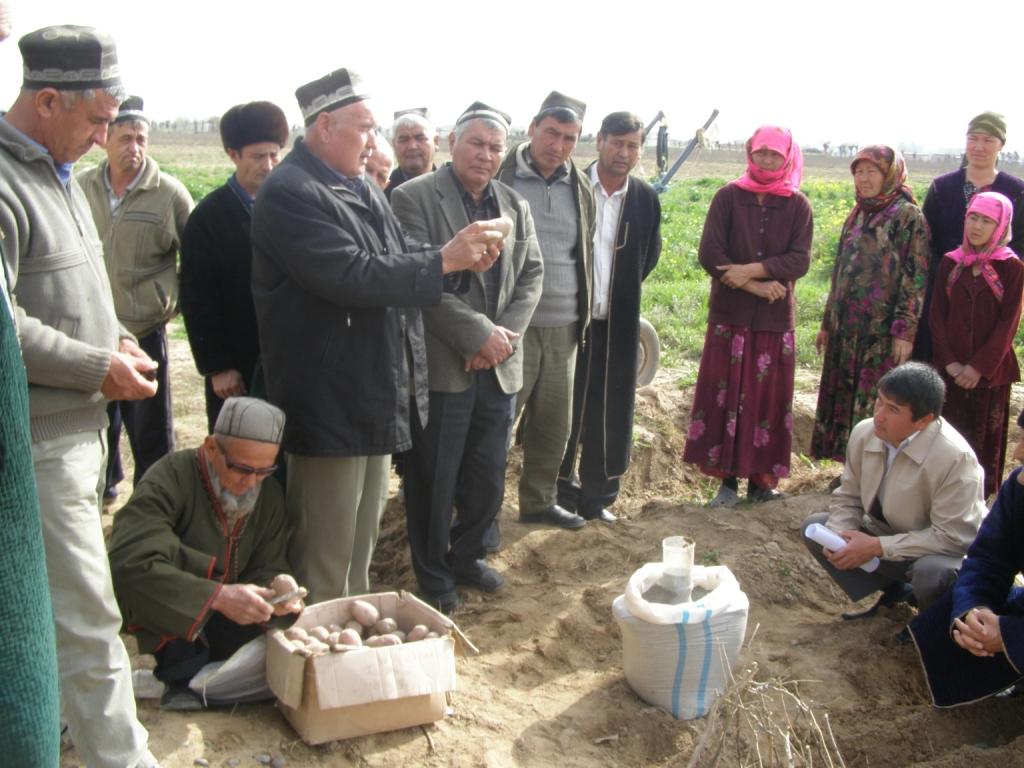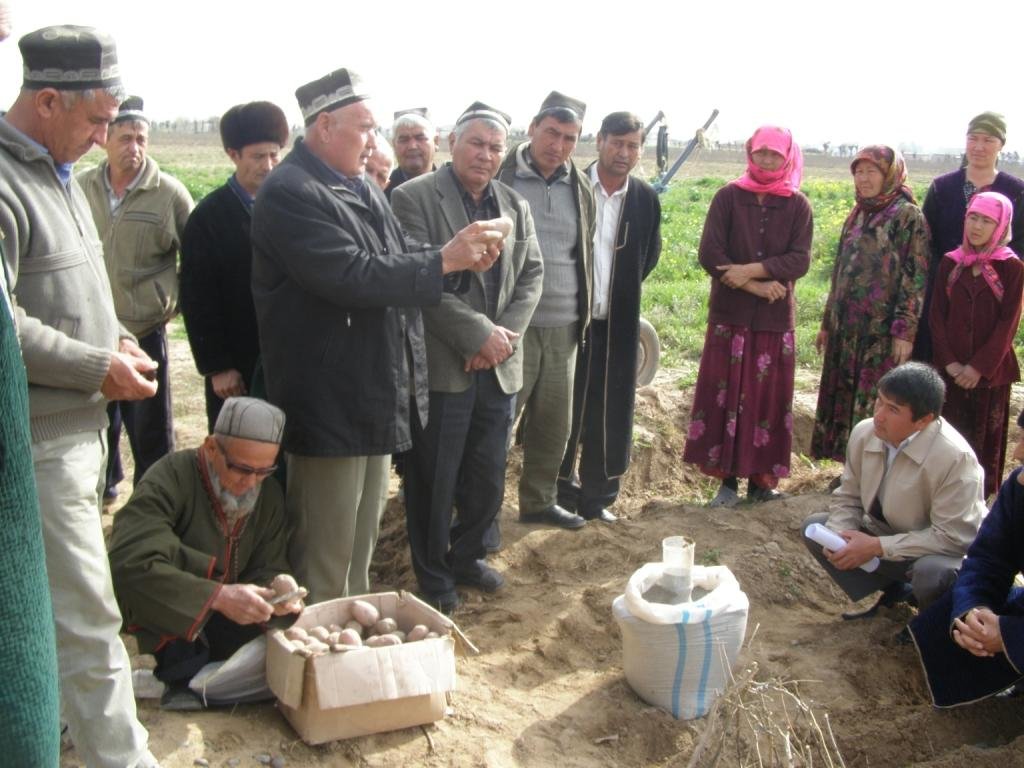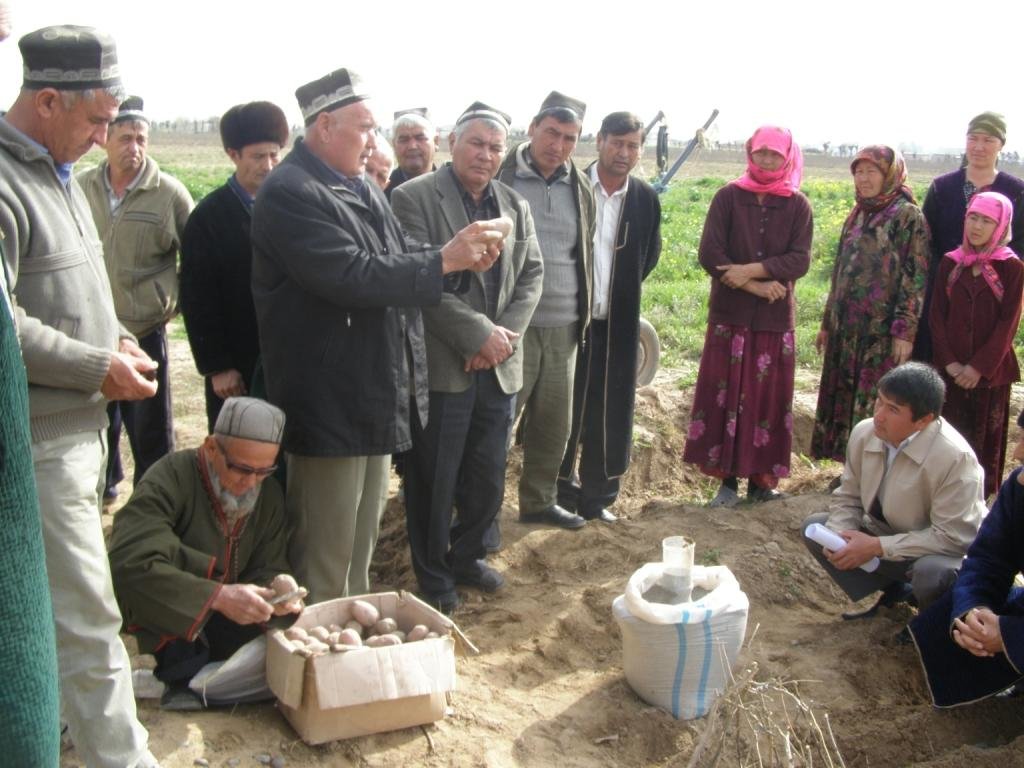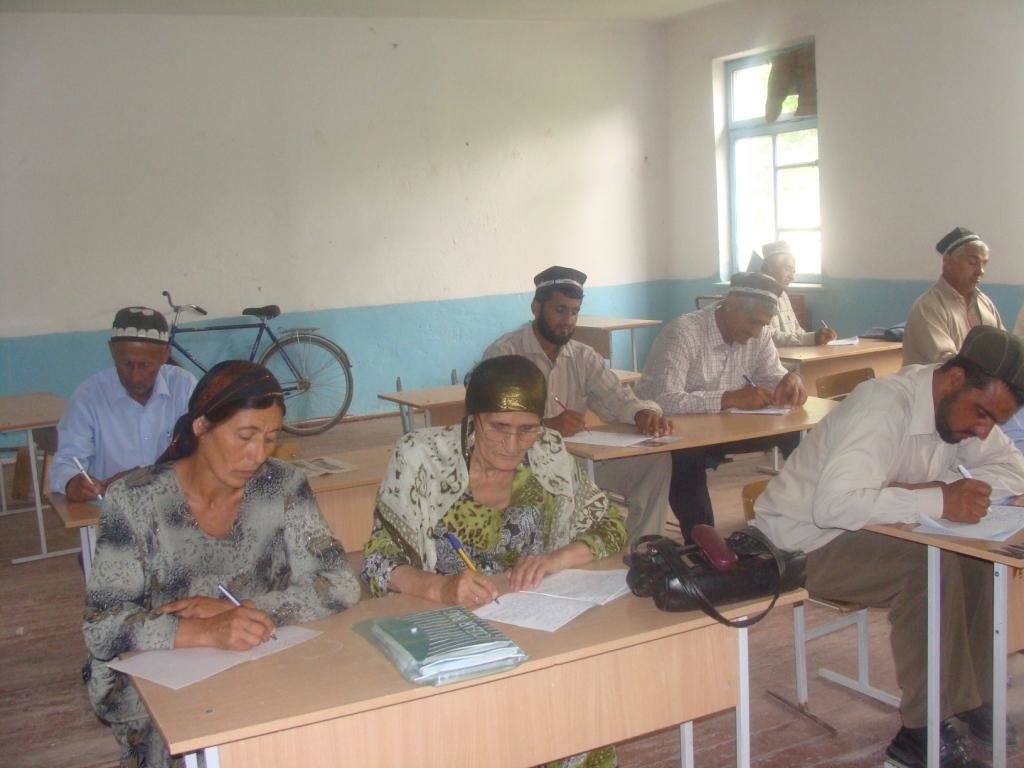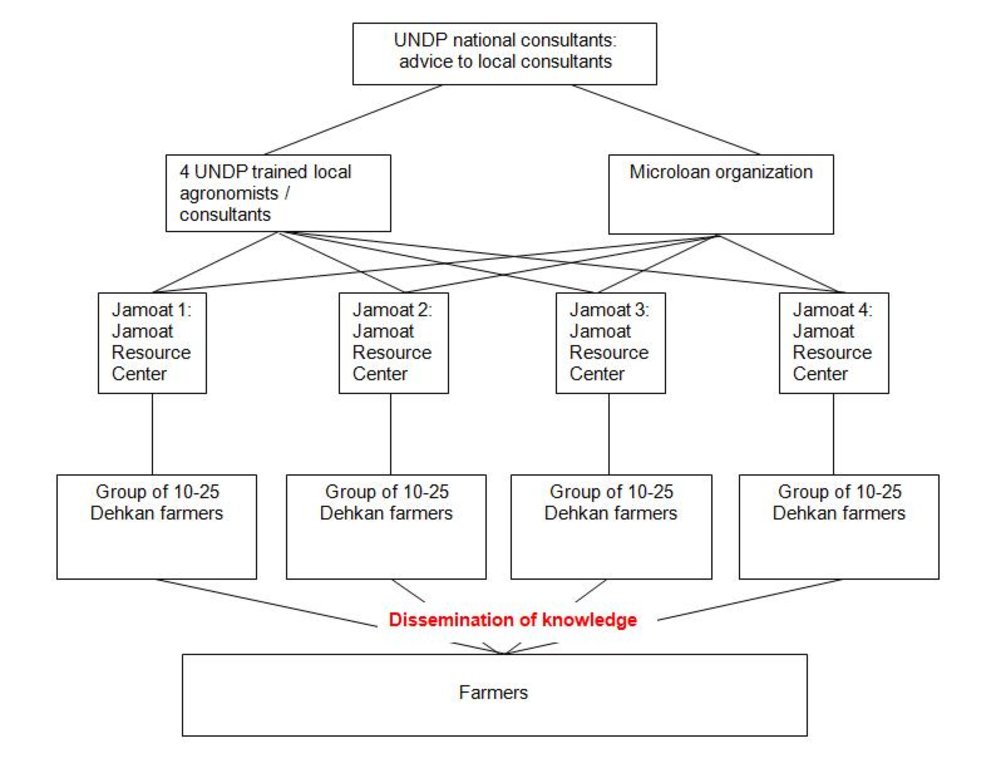Central Asian Countries Initiative for Sustainable Land Management (CACILM) [Tajikistan]
- Creation:
- Update:
- Compiler: Firdavs Faizulloev
- Editor: –
- Reviewer: David Streiff
Фермерские полевые школы
approaches_2439 - Tajikistan
- Full summary as PDF
- Full summary as PDF for print
- Full summary in the browser
- Full summary (unformatted)
- Фермерские полевые школы: Julie 6, 2017 (inactive)
- Central Asian Countries Initiative for Sustainable Land Management (CACILM): Julie 6, 2017 (inactive)
- Central Asian Countries Initiative for Sustainable Land Management (CACILM): Aug. 8, 2017 (inactive)
- Central Asian Countries Initiative for Sustainable Land Management (CACILM): Nov. 2, 2021 (public)
View sections
Expand all Collapse all1. General information
1.2 Contact details of resource persons and institutions involved in the assessment and documentation of the Approach
SLM specialist:
SLM specialist:
SLM specialist:
Urakov Buran
UNDP, Farmers Field School Consultant
Tajikistan
Name of project which facilitated the documentation/ evaluation of the Approach (if relevant)
Central Asian Countries Initiative for Land Management (CACILM I)Name of the institution(s) which facilitated the documentation/ evaluation of the Approach (if relevant)
United Nations Development Program (United Nations Development Program) - TajikistanName of the institution(s) which facilitated the documentation/ evaluation of the Approach (if relevant)
CDE Centre for Development and Environment (CDE Centre for Development and Environment) - Switzerland1.3 Conditions regarding the use of data documented through WOCAT
When were the data compiled (in the field)?
10/03/2010
The compiler and key resource person(s) accept the conditions regarding the use of data documented through WOCAT:
Ja
1.4 Reference(s) to Questionnaire(s) on SLM Technologies
2. Description of the SLM Approach
2.1 Short description of the Approach
Farmer Field Schools (FFS) are held to fill farmer's gaps in knowledge on the use of sustainable agricultural technologies, efficient irrigation water use and prevention of land degradation using trials tailored to local conditions.
2.2 Detailed description of the Approach
Detailed description of the Approach:
Aims / objectives: Farmer field schools are part of the UNDP-GEF project on “Demonstrating Local Responses to Combating Land Degradation and Improving Sustainable Land Management in SW Tajikistan”. They were established with the aim to address the dissemination of sustainable agricultural technologies, and the introduction of new crops. Currently, many farmers in Tajikistan may not previously have been farmers during Soviet times and therefore may lack detailed agricultural knowledge and experience.
Methods: The FFS training is voluntary and the opportunities to attend are announced at Jamoat level. Each year 4 different groups, each comprising 10 to 20 farmers are formed in 4 different Jamoats. The learning comprises a range of activities from classroom teaching to hands-on field experience. The content of the training sessions are effectively adapted to the relevant season and crops as well as to the pests that may occur. The field school addresses some of the following topics; cultivation of winter wheat, potatoes, tomatoes and melons, adequate post harvest handling, use of trees and shelterbelts, generation of quality seeds, pest management, efficient use of irrigation water, etc. The field from which the FFS participants learn about agriculture in practice is a 0.5 ha plot provided by one of the farmers.
Stages of implementation: Before the start of the FFS, 4 local agronomists from target Jamoats were recruited by UNDP and sent on a study tour to Russia. These agronomists in their capacity as a Local FFS Consultant started running FFSs in each Jamoat. Initially, in conjunction with the National FFS Consultant of the SLM project, the local consultants organised several meetings with local farmers in order to identify their training needs. Taking into account the needs of farmers the curricula was prepared and the training schedule was agreed with the farmers/participants.
Role of stakeholders: The project engaged women who are generally considered landless and vulnerable. They were involved in the demo plots on the basis of agreement signed between a local women’s group and a farmer, who owned the land. According to this agreement 70% of the harvest is distributed among the women, and 30% remains for farmer. In addition, many training sessions on pest management, planting of tomatoes, potatoes etc were delivered to women at the demo plot. To ensure food security at the household level training on canning, preparation of juice and how to make jam were conducted. However, more male than female farmers participated in the FFS. This is linked to the fact that the role of male farmers on Dehkan farms is to take decisions on cropping patterns and instruct other farmers. Therefore better dissemination of knowledge is expected from male farmers participating.
Other important information: The project has been efficient in providing micro-loans through an agreement with the micro-loan organisation “Rushdi Obshoron” for agricultural purposes in all four Jamoats, In total, 100,000USD has been distributed to 4 Jamoats.
2.3 Photos of the Approach
2.5 Country/ region/ locations where the Approach has been applied
Country:
Tajikistan
Region/ State/ Province:
Khatlon
Further specification of location:
Shaartuz
Map
×2.6 Dates of initiation and termination of the Approach
Indicate year of initiation:
2007
Year of termination (if Approach is no longer applied):
2011
2.7 Type of Approach
- project/ programme based
2.8 Main aims/ objectives of the Approach
The Approach focused mainly on other activities than SLM (agricultural production, market regulation, value chain development, seed multiplication )
The main aim of the approach is to support a change in mindset from a collective farming (Kolhoz) approach led by the state, onto private farmers putting more responsibility with the land users themselves. Since the collapse of the Soviet Union, many collective farms disintegrated and as a result of land reforms, the Dehkan farms came into being. People without an agricultural background could set up their own Dehkan farms and become farmers. However, a lack of knowledge and expertise frequently led to inappropriate land use which has contributed to land degradation. The objectives of FFS are to provide training sessions to farmers to improve their knowledge of better farming practices and the more rational use of land and water resources.
The SLM Approach addressed the following problems: lack of technical agricultural and ‘market economy’ knowledge, poverty
2.9 Conditions enabling or hindering implementation of the Technology/ Technologies applied under the Approach
social/ cultural/ religious norms and values
- hindering
Many women in the region do not own their own land and can therefore be very vulnerable
Treatment through the SLM Approach: They were involved in the FFS receiving special training on pest management, planting of tomatoes, potatoes, vegetable canning, preparation of juice etc. A benefit sharing agreement was signed between the women’s group and the farmer who owned the land
availability/ access to financial resources and services
- hindering
Lack of financial resources to buy fuel, fertilisers, livestock etc.
Treatment through the SLM Approach: A microloan organisation is providing credit loans from 2000-9000 Somoni (450-2,000 USD)
legal framework (land tenure, land and water use rights)
- hindering
The existing land ownership, land use rights / water rights moderately hindered the approach implementation Initially, farmers had no freedom to farm, meaning they were not allowed to choose which crops they would grow, however, after the economic crisis this changed.
knowledge about SLM, access to technical support
- hindering
In general farmer’s agricultural knowledge is weak. Especially as after the collapse of the Soviet Union anybody could get some land and become a farmer, even people who did not have a traditional farming background and therefore no agricultural knowledge
Treatment through the SLM Approach: In the field schools farmers are receiving training about new agricultural technologies and have the chance to get advice about their particular problems
other
- hindering
No quality seeds were available
Treatment through the SLM Approach: UNDP provided seeds and ensured that a multiplication mechanism took place
3. Participation and roles of stakeholders involved
3.1 Stakeholders involved in the Approach and their roles
- local land users/ local communities
Local agronomists from Jamoat level were sent to Russia on a study trip to learn from Russian experiences with sustainable land management
Landless women, individual farmers
Only 1/3 of the participants were women. This is linked to the fact that the role of male farmers on Dehkan farms is to take decisions on cropping patterns and instruct other farmers. Therefore better dissemination of knowledge is expected from male farmers participating.
Landless women who are very vulnerable.
- SLM specialists/ agricultural advisers
International specialists
National and local level consultants
- NGO
National agronomists working as consultants for UNDP
- international organization
UNDP
If several stakeholders were involved, indicate lead agency:
UNDP
3.2 Involvement of local land users/ local communities in the different phases of the Approach
| Involvement of local land users/ local communities | Specify who was involved and describe activities | |
|---|---|---|
| initiation/ motivation | passive | |
| planning | passive | |
| implementation | passive | Farmers only participated in FFS and were not involved in developing the content of training |
| monitoring/ evaluation | interactive | No monitoring of the theoretical part of the approach took place, monitoring of land users success in applying the taught practices included interactive participation of land users. |
| Research | interactive | Some research on crop performance was undertaken with interactive involvement of land users. |
3.3 Flow chart (if available)
Description:
Before the start of the FFS 4 local agronomists from target Jamoats were recruited by UNDP and sent on a study tour to Russia. These local FFS consultants then started running a FFS in each Jamoat.
Author:
Julie Zähringer (Baumackerstr. 51, 8050 Zürich)
3.4 Decision-making on the selection of SLM Technology/ Technologies
Specify who decided on the selection of the Technology/ Technologies to be implemented:
- mainly SLM specialists, following consultation with land users
Explain:
Decisions on the method of implementing the SLM Technology were made by mainly by SLM specialists with consultation of land users
4. Technical support, capacity building, and knowledge management
4.1 Capacity building/ training
Was training provided to land users/ other stakeholders?
Ja
Specify who was trained:
- land users
- field staff/ advisers
Form of training:
- on-the-job
- farmer-to-farmer
- demonstration areas
- courses
Subjects covered:
Sustainable irrigation water use, integrated crop management, tree planting for biodrainage, preventing gully formation, crop storage, effective seed production, pest management
4.2 Advisory service
Do land users have access to an advisory service?
Ja
Specify whether advisory service is provided:
- on land users' fields
Describe/ comments:
Farmer Field Schools: Key elements: Classroom courses, Farmer to farmer visits, Demonstration plots; Research is done on demonstration plots. Farmer to farmer visits are needed for an exchange of experience between different farmers.
Advisory service is quite adequate to ensure the continuation of land conservation activities; As they were provided with adequate training, the local level consultants are now able to continue holding training in farmer field schools. If the provision of micro-loans and the pay-back scheme keep working, funding will be available to ensure continuation.
4.3 Institution strengthening (organizational development)
Have institutions been established or strengthened through the Approach?
- yes, moderately
Specify the level(s) at which institutions have been strengthened or established:
- local
Specify type of support:
- financial
- capacity building/ training
Give further details:
infrastructure, classrooms
4.4 Monitoring and evaluation
Is monitoring and evaluation part of the Approach?
Ja
Comments:
technical aspects were regular monitored by project staff through measurements; indicators: on farm productivity
bio-physical aspects were ad hoc monitored by land users through observations; indicators: market situation
economic / production aspects were regular monitored by project staff through observations; indicators: None
no. of land users involved aspects were regular monitored by project staff through measurements; indicators: None
There were no changes in the Approach as a result of monitoring and evaluation: None
There were several changes in the Technology as a result of monitoring and evaluation: Exchange of experiences between different Jamoats (Jamoats differed in types of crops cultivated).
4.5 Research
Was research part of the Approach?
Ja
Specify topics:
- economics / marketing
- ecology
- technology
Give further details and indicate who did the research:
Experiments about intercropping of different crop species. Local consultants also undertook research on marketing of different crops, which crop should be grown, and when for example, in order to achieve the best prices.
Research was carried out on-farm
5. Financing and external material support
5.1 Annual budget for the SLM component of the Approach
If precise annual budget is not known, indicate range:
- 100,000-1,000,000
Comments (e.g. main sources of funding/ major donors):
Approach costs were met by the following donors: international (GEF / UNDP): 100.0%
5.2 Financial/ material support provided to land users
Did land users receive financial/ material support for implementing the Technology/ Technologies?
Nee
5.3 Subsidies for specific inputs (including labour)
- labour
| To which extent | Specify subsidies |
|---|---|
| fully financed | Salary of consultants |
- equipment
| Specify which inputs were subsidised | To which extent | Specify subsidies |
|---|---|---|
| machinery | not financed | |
- agricultural
| Specify which inputs were subsidised | To which extent | Specify subsidies |
|---|---|---|
| seeds | fully financed | |
- infrastructure
| Specify which inputs were subsidised | To which extent | Specify subsidies |
|---|---|---|
| classrooms | fully financed | |
- other
| Other (specify) | To which extent | Specify subsidies |
|---|---|---|
| Study trip for local consultants to Russia | fully financed |
If labour by land users was a substantial input, was it:
- voluntary
5.4 Credit
Was credit provided under the Approach for SLM activities?
Ja
Specify conditions (interest rate, payback, etc.):
Interest rate charged: 1.5%; repayment conditions: A microloan organisation was established and equiped by UNDP with a starting capital of USD 200,000. The interest rate is 1.5% per month, which is considered low compared to credits provided by other financial institutions. Moreover, it requires very limited papers to be provided for get a loan. Farmers pay back loans in cash. .
Interest was lower than market rate.
5.5 Other incentives or instruments
Were other incentives or instruments used to promote implementation of SLM Technologies?
Nee
6. Impact analysis and concluding statements
6.1 Impacts of the Approach
Did the Approach help land users to implement and maintain SLM Technologies?
- No
- Yes, little
- Yes, moderately
- Yes, greatly
More holistic thinking, including crop selection, cultural practices, conservation, integrated pest management etc. However, the number of farmers participating in field schools is still somewhat limited.
Did the Approach empower socially and economically disadvantaged groups?
- No
- Yes, little
- Yes, moderately
- Yes, greatly
Landless women were engaged in the field schools. The women groups kept 70% of the crop yield, while 30% was paid to the landowner of the demonstration plot. Food security increased for the women.
Did the Approach improve issues of land tenure/ user rights that hindered implementation of SLM Technologies?
- No
- Yes, little
- Yes, moderately
- Yes, greatly
The approach could not reduce the problem, it was a governmental decision. The problem is likely to be overcome in the near future.
Did other land users / projects adopt the Approach?
- No
- Yes, little
- Yes, moderately
- Yes, greatly
The approach has not yet been disseminated over the country.
Did the Approach lead to improved livelihoods / human well-being?
- No
- Yes, little
- Yes, moderately
- Yes, greatly
higher crop yields
Did the Approach help to alleviate poverty?
- No
- Yes, little
- Yes, moderately
- Yes, greatly
Higher income through increased crop production.
6.2 Main motivation of land users to implement SLM
- increased production
- prestige, social pressure/ social cohesion
- agricultural knowledge
- well-being and livelihoods improvement
6.3 Sustainability of Approach activities
Can the land users sustain what has been implemented through the Approach (without external support)?
- yes
If yes, describe how:
Farmers who were trained in the field schools are now able to disseminate their knowledge to other farmers. For this they receive some 'in kind' contribution from the farmers they teach such as seeds etc.
6.4 Strengths/ advantages of the Approach
| Strengths/ advantages/ opportunities in the land user’s view |
|---|
| Increased crop yields lead to increased family budget (How to sustain/ enhance this strength: Ensure application of taught practices.) |
| The farmers feel confident about what they do and are keen to disseminate their knowledge to other farmers (How to sustain/ enhance this strength: Dissemination of knowledge to other farmers so that more people can profit, for example through farmer to farmer visits) |
| The farmers know which crops to cultivate and how to adapt to the market conditions. |
| Integrated pest management helps to fight diseases and leads to better onion yield (How to sustain/ enhance this strength: Apply integrated pest management on all fields.) |
| Strengths/ advantages/ opportunities in the compiler’s or other key resource person’s view |
|---|
| The farmers are trained on the rational use of land and water resources which helps to reduce land degradation. (How to sustain/ enhance this strength: An emphasis has to be put on the prevention of land degradation.) |
| Farmers from different backgrounds enrich their farming practices and fill gaps in agricultural knowledge Topics taught in FFS should be diversified and continually updated. (How to sustain/ enhance this strength: Topics taught in FFS should be diversified and always be up to date.) |
6.5 Weaknesses/ disadvantages of the Approach and ways of overcoming them
| Weaknesses/ disadvantages/ risks in the compiler’s or other key resource person’s view | How can they be overcome? |
|---|---|
| Until now the FFS were running free of charge to the participants, however, this should be changed in order to raise more money to continue with the field schools, but farmers might not be willing to pay immediately, it takes some time before the farmers realise the significance of the FFS | Farmers would be more willing to pay if they were asked for in kind contributions, rather tha cash. |
7. References and links
7.1 Methods/ sources of information
- field visits, field surveys
- interviews with land users
Links and modules
Expand all Collapse allLinks
No links
Modules
No modules


